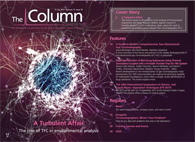A Turbulent Affair
The Column spoke to Ethel Eljarrat of the Institute of Environmental Assessment and Water Research (IDÆA), Spanish Council of Scientific Research (CSIC), in Barcelona, Spain, about her work in environmental analyses using turbulent flow chromatography (TFC).
Photo Credit: amiak/Shutterstock.com

The Column spoke to Ethel Eljarrat of the Institute of Environmental Assessment and Water Research (IDÆA), Spanish Council of Scientific Research (CSIC), in Barcelona, Spain, about her work in environmental analyses using turbulent flow chromatography (TFC).-Interview by Kate Mosford
Q. What is turbulent flow chromatography (TFC)?
A: Turbulent flow chromatography (TFC) was developed in the late 1990s, and combines “size exclusion” and traditional stationary phase column chemistry to separate macromolecules, such as proteins, from smaller molecules and analytes of interest. TFC is used for on-line sample cleanup of biological matrices in liquid chromatography–mass spectrometry (LC–MS) applications. The determination of contaminants in biological fluids or tissues has been a challenging task for a very long time. This was due to the complexity of the biological matrices, which required timeconsuming sample preparation steps. The recent implementation of on-line extraction (including TFC) has allowed fast sample cleanup and partly removed the bottleneck associated with sample preparation. TFC methods are based on the direct injection of biological extracts without previous cleanup onto a column packed with large particles.
After the sample is injected onto a column that utilizes TFC, the high flow rate (1.5–5.0 mL/min) generates turbulent flow conditions inside the column. The small analyte molecules are retained via diffusion into the particle pores, while the proteinaceous material is washed to waste. Once the compounds of interest are extracted from the biological matrix, they are eluted from this column onto the analytical column.
Q. In 2016, your group published a study analyzing organophosphorus flame retardants (OPFRs) in environmental matrices using TFC (1). What led your group to begin this study?
A: Our group has been studying the environmental impact of halogenated flame retardants (HFRs) for more than 15 years. However, in recent years, the scientific community has focused their attention on evaluating the environmental impact produced by another family of flame retardants (FRs), the organophosphorus FRs (OPFRs). Previous studies showed high levels of contamination in environmental and biotic samples, often with even higher levels than those found for HFRs-some of which have already been banned at international scale (1,2). Moreover, some of these compounds are neurotoxic, endocrine disruptors, and carcinogenic (3,4).
Taking this into account, appropriate analytical methods for OPFR determination and quantification are needed. Unlike halogenated FRs, which are analyzed by gas chromatography (GC), OPFRs are determined by liquid chromatography (LC). Our group previously investigated the simultaneous determination of 16 OPFRs in fish by LC–MS/MS (5). However, offâline extraction and cleanup steps must be performed, once more making the sample preparation step the bottleneck of the analytical process.
TFC has been previously optimized and applied for the determination of other contaminants, such as pesticides, perfluoroalkyls, or veterinary drugs (6,7). Therefore, our group decided to develop an analytical method based on TFC to determine OPFRs in environmental and biological matrices, reducing the sample preparation steps and minimizing the time of analysis.
Q. What were the main analytical challenges you encountered and how did you overcome them?
A: One of the main challenges encountered in this study was the physicoâchemical differences between selected analytes, with molecular weight ranging from 266 to 452, and log KOW ranging between 1.71 and 9.49. With the use of turbulent flow, large molecules (for example, proteins and lipids) pass through the purification column, while the smaller molecules are retained on the porous cavities of the column packing. Thus, clean extracts without interfering compounds are achieved. In our tests, two OPFRs, tris(2-ethylhexyl)phosphate (TEHP) and trihexyl phosphate (THP), which are the larger molecules, presented the lowest recoveries. Thus, a second purification column was added to retain these compounds and avoid their loss with the turbulent flow. With the addition of a C18 column, it was possible to obtain good recoveries for all the selected analytes.
A further critical point is the transfer time when purification and analytical columns were connected. This time had to be reduced to the maximum, 120 s, to obtain the optimum conditions where the target compounds had been transferred onto the analytical column and sample matrix remained in the purification column that utilized TFC.
Another important aspect that should be noted is the complexity of the analyzed samples. In the case of environmental samples (for example, sediments), this is not so critical, and no problems were found when selecting the extraction method. We chose to use pressurized liquid extraction (PLE), which is a fast and automatic extraction method. However, for biological samples with many ingredients and a high fat content, the selection of appropriate sample extraction is a crucial step for the correct development of the method. In this case, the best option was an ultrasound extraction because it is a mild extraction method, allowing a lower number of interfering compounds in the obtained extracts.
Q. Are OPFRs becoming a bigger issue within the environment?
A: As mentioned before, OPFRs constitute another family of chemical compounds widely used and applied as flame retardants. They are also used as plasticizers, and the plastic industry is one of the largest industries worldwide. Unfortunately, even though plastics
have made our lives easier, the contamination produced by them is undeniable. This is produced not only for the material itself, but also by the chemicals used in its manufacturing.
To give stability to these polymers,
some chemicals known as plasticizers are added into the mixture. Both applications, as flame retardants and as plasticizers, make these substances into chemical compounds produced on a large industrial scale.
A recent published review (8) has highlighted the concentration levels usually found in different environmental compartments, such as air, water, sediment, and soil. There are several articles where the presence of OPFRs is confirmed in fish from different world locations (1,2,9–11). These works showed high concentrations of OPFRs in comparison to the average levels found for PBDEs, the most widely used HFRs, and included on the list of Stockholm Convention, which regulates the elimination of persistent organic pollutants (POPs).
Q. What can TFC coupled to LC–MS/MS offer over other techniques?
A: TFC coupled to LC–MS/MS offers a simple and easy method of analysis of organic pollutants in complex matrices. By performing only one extraction step, we are able to quickly and easily determine the contaminants of interest in biological matrices. The obtained sensitivity and selectivity are higher than those obtained by classical off-line methodologies.
Q. Can this technology or method be used in any other applications?
A: Based on the good results obtained in our study, we want to optimize analytical methods for OPFR determinations in other complex matrices, such as human fluids (plasma, urine). We also plan to focus on the use of TFC for the determination of other emerging contaminants of interest, such as pharmaceuticals and personal care products.
Q. What results did you find?
A: A fast on-line analytical method based on TFC in combination with MS/MS has been developed obtaining acceptable recoveries (between 47% and 112% for sediment, and between 47% and 98% for fish) with very low relative standard deviations (always below 8.8% for sediment, and below 16% for fish). Moreover, limits of detection (LODs) and limits of quantification (LOQs) are similar or even lower than those reported in other works using off-line methodologies (1). LODs ranged between 0.02 and 1.25 ng/g dry weight (dw) and between 0.19 ng/g and 19.3 ng/g lipid weight (lw) for sediments and fish samples, respectively. The applicability of the developed methodology was demonstrated by the analysis of real samples, corresponding to river sediments as well as river and marine fish samples. OPFRs were detected in all samples, with values up to 549 ng/g dw, 15.8 ng/g lw, and 646 ng/g lw for sediment, marine fish, and river fish, respectively. As expected, lower contamination was found in the marine environment because of the water dilution.
References
- M. Giulivo, E. Capri, E. Eljarrat, and D. Barceló, J. Chromatogr. A1474, 71–78 (2016).
- M. Giulivo, E. Capri, E. Kalogianni, R. Milacic, B. Majone, F. Ferrari, E. Eljarrat, and D. Barceló, Science of the Total Environment in press (2017).
- X. Liu, K. Ji, and K. Choi, Aquat. Toxicol. 114–115, 173–181 (2012).
- I. van der Veen and J. de Boer, Chemosphere88, 1119–1153 (2012).
- G. Santín, E. Eljarrat, and D. Barceló, J. Chromatogr. A1441, 34–43 (2016).
- A.M. Stolker, R.B. Peters, R. Zuiderent, J.M. Di Bussolo, and C.P.B. Martins, Anal. Bioanal. Chem.397, 2841–3849 (2010).
- M. Llorca, F. Pérez, M. Farré, S. Agramunt, M. Kogevinas, and D. Barceló, Sci. Total. Environ. 433, 151–160 (2012).
- G.-L. Wei, D.-Q. Li, M.-N. Zhuo, Y.-S. Liao, Z.-Y. Xie, T.-L. Guo, J.-J. Li, S.-Y. Zhang, and Z.-Q. Liang, Environ. Pollut.196, 29–46 (2015).
- S.H. Brandsma, P.E. Leonards, H.A. Leslie, and J. de Boer, Sci. Total Environ.505, 22–31 (2015).
- G. Malarvannan, C. Belpaire, C. Geeraerts, I. Eulaers, H. Neels, and A. Covaci, Environ. Res.140, 604–610 (2015).
- H. Matsukami, G. Suzuki, N.M. Tue, H. Tuyen le, P.H. Viet, S. Takahashi, S. Tanabe, and H. Takigami, Emerg. Contam. 2, 89–97 (2016).

Ethel Eljarrat Esebag obtained her Ph.D. in chemistry at the University of Barcelona in 1999. Since July 2008 she has been a scientific researcher at the Institute of Environmental Assessment and Water Research (IDÆA), Spanish Council of Scientific Research (CSIC), in Barcelona, Spain. She has published more than 140 research papers (H index = 35), and she is editor of two books (Brominated Flame Retardants (BFRs) and Emerging Organic Contaminants in Sludges). Her research area includes the development of analytical methodologies for the study of the presence and environmental behaviour of organic persistent pollutants, as well as of emerging contaminants, such as halogenated and organophosphate flame retardants, and pyrethroid insecticides, in different environmental compartments and biota samples. She has worked across different studies related to pollution in aquatic and terrestrial ecosystems and in some of these studies she combined and related the study of the environmental levels with the effects on the aquatic organisms.
E-mail: eeeqam@iiqab.csic.esWebsite: www.idaea.csic.es/index.php

Silvia Radenkovic on Building Connections in the Scientific Community
April 11th 2025In the second part of our conversation with Silvia Radenkovic, she shares insights into her involvement in scientific organizations and offers advice for young scientists looking to engage more in scientific organizations.
Regulatory Deadlines and Supply Chain Challenges Take Center Stage in Nitrosamine Discussion
April 10th 2025During an LCGC International peer exchange, Aloka Srinivasan, Mayank Bhanti, and Amber Burch discussed the regulatory deadlines and supply chain challenges that come with nitrosamine analysis.
Silvia Radenkovic on Her Research and Passion for Scientific Collaboration
April 3rd 2025Silvia Radenkovic is a laboratory clinical biochemical genetics fellow at UMC Utrecht, the Netherlands and a member of Females in Mass Spectrometry (FeMS). She is currently doing a clinical fellowship where she is involved in diagnosing and helping treat patients with inborn metabolic diseases (IMD). Her research focuses on IMD such as congenital disorders of glycosylation (CDG), omics techniques such as tracer metabolomics, and different disease models.











